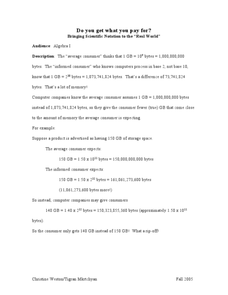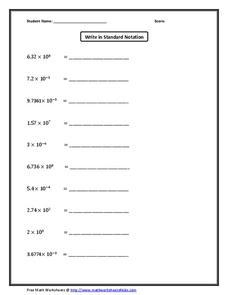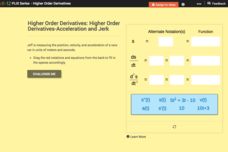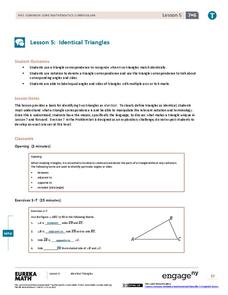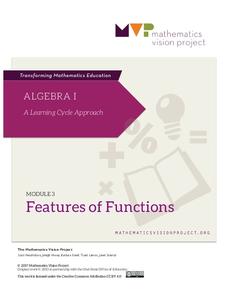EngageNY
Scientific Notation
Young mathematicians learn how scientific notation is meant to save time. Part 10, out of a series of 15, asks scholars to recognize the correct use of scientific notation and finish by adding and subtracting numbers using...
Curated OER
Place Value of Whole Numbers Through One Million
Third graders construct numbers to the millions place. In this 30-page place value lesson, learners create numbers and evaluate the place value of digits. They explore standard and expanded form of numbers. An incredible resource!
Curated OER
Passive Integrator and Differentiator Circuits
In this circuits worksheet, students answer 25 questions about passive integrator circuits and passive differentiator circuits given schematics showing voltage. Students use calculus to solve the problems.
Virginia Department of Education
Exponents
Expand your knowledge of exponents with an activity that promotes critical thinking and comparison skills. Middle and high schoolers compare numbers written in expanded and exponential form and explain their strategies for solving...
Curated OER
Do You Get What You Pay For?
Consumers explore scientific notation as it relates to the real world. In this algebra instructional activity, mathematicians convert Gigabytes in to scientific notation to see if they are being cheated. They differentiate between base...
Virginia Department of Education
Composition of Functions
Analyze functions by decomposing complex functions and composing simple functions. Through a detailed lesson plan, pupils learn the vocabulary and notation related to the composition of functions. Practice includes both evaluating and...
EngageNY
Directed Line Segments and Vectors
Investigate the components of vectors and vector addition through geometric representations. Pupils learn the parallelogram rule for adding vectors and demonstrate their understanding graphically. They utilize the correct notation and...
EngageNY
Numbers in Exponential Form Raised to a Power
Develop an understanding of the properties of exponents through this series of activities. This third lesson of 15 explores the patterns associated with the power property. Scholars expand the powers before applying the property.
EngageNY
Similarity
Learn similarity through a transformations lens! Individuals examine the effects of transformations and analyze the properties of similarity, and conclude that any image that can be created through transformations is similar. The...
Virginia Department of Education
Scientifically Speaking
Explore the connection between operations with scientific notation and the laws of exponents. Scholars work on a set of word problems involving operations with scientific notation. Along the way, they consider how the laws of exponents...
Curated OER
Write in Standard Notation
In this algebra worksheet, 10th graders rewrite scientific numbers using standard notation. They differentiate between positive and negative exponents. There are 10 problems with an answer key.
EngageNY
Recursive Challenge Problem—The Double and Add 5 Game
Math is all fun and games! Use a game strategy to introduce the concept of sequences and their recursive formulas. The activity emphasizes notation and vocabulary.
Flipped Math
Calculus AB/BC - Calculating Higher-Order Derivatives
Derivatives are so fun that sometimes one wants to take the derivative multiple times. The sixth of seven installments in Unit 3 - Differentiation focuses on finding higher-order derivatives. After learning about the notation, scholars...
CK-12 Foundation
Higher Order Derivatives—Acceleration and Jerk
Accelerate your class through finding the second derivative. Using a bank of equations, pupils determine the equations for distance, velocity, and acceleration and their associated function notations. With the equations, learners answer...
Curated OER
Study Guide for the Advanced Placement Calculus AB Examination
Is this going to be on the test? A calculus study guide provides an organized list of important topics and a few examples with answers. The topics include elementary functions, limits, differential calculus, and...
EngageNY
Identical Triangles
Explore vocabulary and notation related to triangles and congruence. The fifth lesson in the 29-part series helps pupils build their knowledge of triangle relationships. Individuals identify corresponding parts of identical triangles and...
EngageNY
Construct and Apply a Sequence of Rigid Motions
Breaking the rules is one thing, proving it is another! Learners expand on their previous understanding of congruence and apply a mathematical definition to transformations. They perform and identify a sequence of transformations and use...
Curated OER
Math 155 Worksheet 1
In this college level Calculus worksheet, students review factoring, rationalization of a denominator, and functional notation to prepare for differentiation. The two page worksheet contains six problems. Answers are not...
Curated OER
Math 155 - Worksheet 10. Logarithm
In this logarithm worksheet, students read story problems, write an equation to solve the problem, and leave the answer in logarithm or exponential form. They find the derivative of given functions. This two-page worksheet contains six...
Curated OER
Implicit Differentiation
In this implicit differentiation instructional activity, students use the chain rule to solve for the derivative. The find the equation for the tangent line at a given point and determine if the line is vertical. This two-page...
Curated OER
Reading Music Notation
Ninth graders develop an understanding of music notation and become proficient at reading rhythms by sight. They explore rhythms base on divisions of two and four and triplets.
EngageNY
Magnitude
Build an understanding of the powers of 10. Pupils investigate the results of raising 10 to positive and negative powers. They relate this understanding to the magnitude these powers represent in this seventh lesson of 15.
Mathematics Vision Project
Module 3: Features of Functions
Learn how to represent functions in multiple ways. Learners analyze functions as equations, graphs, and verbal descriptions. The analysis includes intercepts, behavior, domain, and range. The module of seven lessons makes up the third...
Virginia Department of Education
Calculating Measures of Dispersion
Double the fun — calculate two measures of deviation. The lesson plan provides information to lead the class through the process of calculating the mean absolute deviation and the standard deviation of a data set. After learning how to...




